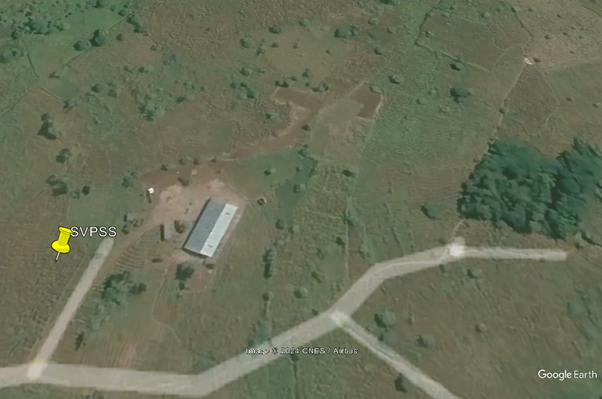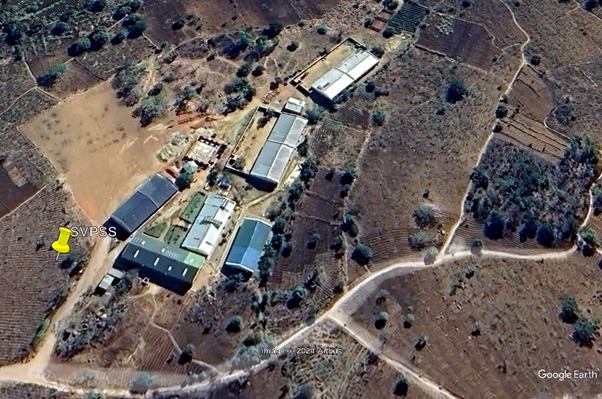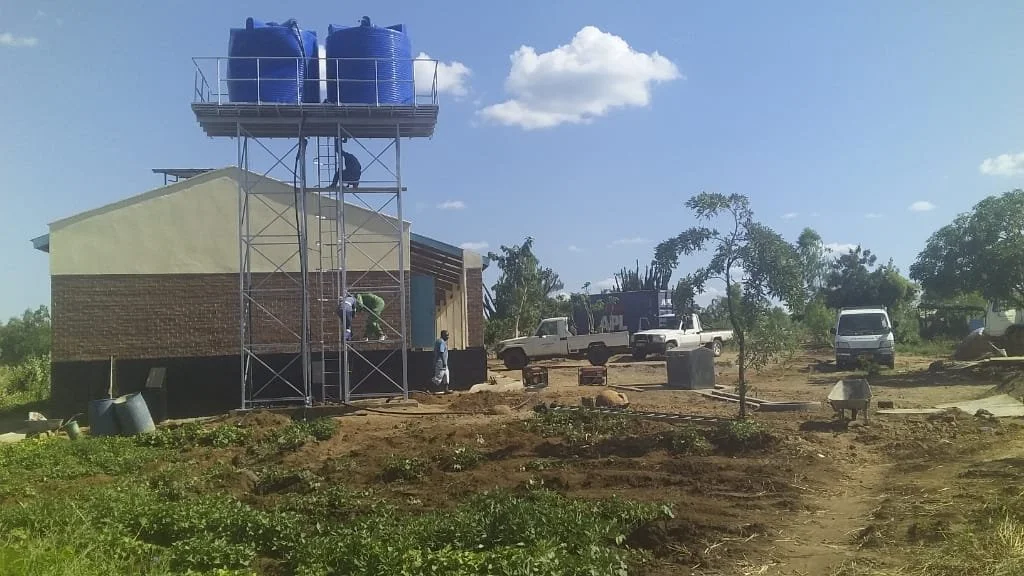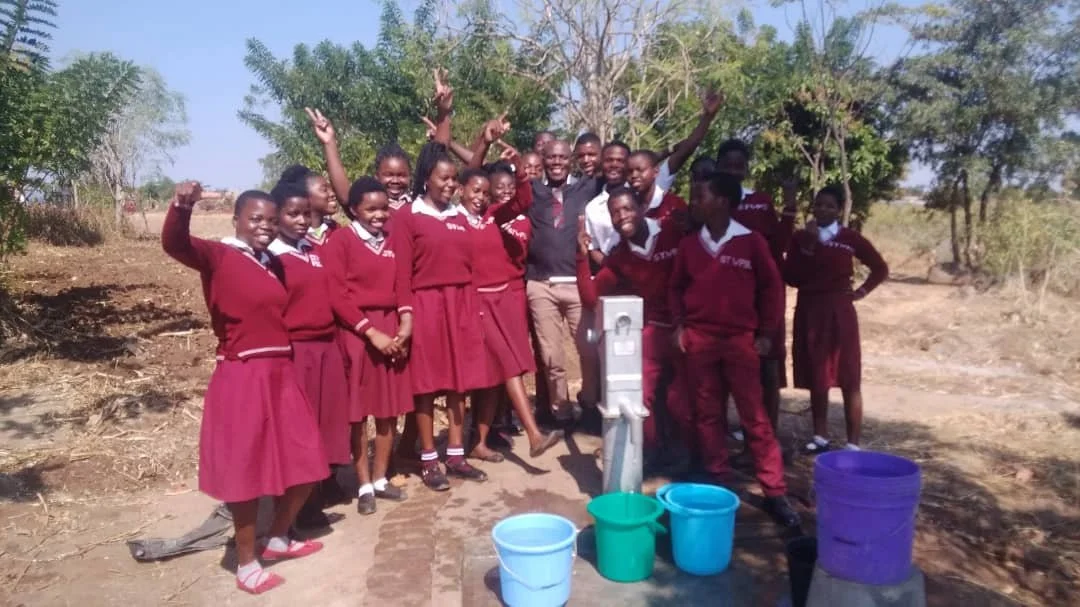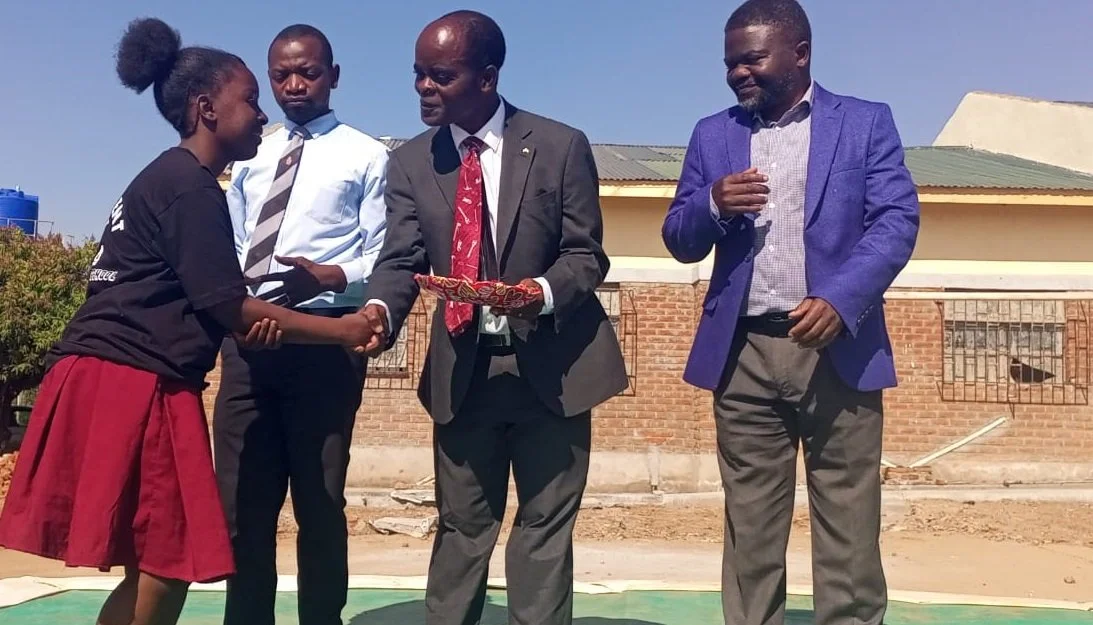St Vincent de Paul Secondary School (SVPSS)
Google Earth picture March 2020
The decision to build this school was taken in October 2019. The two classroom block was completed six months later. A solar powered borehole was installed along with solar powered security lighting and power supply. Before the school was opened in January 2021, a septic tank and toilet blocks for females and males were needed. Students may live up to 35Km away so accommodation was also required; a hostel for girls was built first. A kitchen with stoves for food preparation was also essential.
Google Earth picture August 2024
Copying these coordinates 15°40'0.00"S 34°53'21.00"E and pasting into Google Earth Search box should produce a placemark near the school.
Historical imagery of the buildings appearing from 2019 to date can be seen using the icon on the top line that looks like an alarm clock.
First classroom block and tanks for solar powered borehole
Delighted with their new additional water supply
Front part of the new library at SVPSS
Second hostel completed September 2021
Some laboratory equipment purchased but much more is needed
Prize giving at SVPSS.
2021, a second hostel for boys completed.
A high brick wall (locally called a “brick fence”!) was built in front of each of the two hostels. This wall surrounds the area at the front of the hostel so students can relax or study outside and dry their washing in privacy.
2022, a triple classroom block was built
2023, an additional borehole was drilled with a manual pump. In dull weather, the solar powered supply was inadequate in the early morning.
2023-2024, the construction of a building with two laboratories for practical classes and practical exams in Physics, Chemistry, Biology and Agriculture.
In 2024, a library was built.
The associated needs of each new building such as desks, lab benches, shelving, beds, mattresses, solar power and security lighting have been provided
Although we have used some excellent carpenters, termites eating wood are a major problem in this area so shelves in the library are metal.
Problems with solar system in 2023 have been resolved. New batteries and hybrid inverters have been installed so that the grid can be used if solar power is inadequate in dull weather.
Additional achievements
SVPSS now has 566 students receiving Secondary education. Just under a half of the students come from a distance and are boarders. Others pay for accommodation in village houses. There are no Secondary schools in the 62Km between Chikuli and Mwanza.
National exam results were particularly pleasing in 2024 - above the National pass rates which include well funded National and Regional schools.
JCE second year exam. SVPSS 87 (72%) passed (National pass rate ≈71%)
MSCE fourth year exam. SVPSS 85 (57%) passed. (National pass rate ≈55%)
These results are particularly good because a considerable number did not do well enough at Primary School to get an offer of place in Secondary Education; this applies to more than half Form 1 this year.
So these students are receiving education that they would not otherwise be getting. Secondary education and National exams will be more difficult for them. Remedial classes are held in the evenings and at weekends
Enthusiastic students are getting good results
Out of 52 students who were awarded MSCE in 2022, 40 went on to University or other higher education last year
Experiments during a practical class in the lab
Students do not take all subject options. The library can be used when another subject is being taught in their classroom.
The laboratories are used for Physics, Chemistry, Biology and Agriculture praticals.
The other bonus is that students will be able to sit National exam practicals in their own school rather than travelling to a strange school and lab to sit these exams
The new library is being well used
Background to this school
When we were offered the opportunity to build in this area near Chikuli, we went ahead because there is considerable demand here for Secondary education but few opportunities. Between Blantyre Airport at Chileka and Mwanza 73 Km to the west, there are three fairly small Secondary schools. One is a small private school. The others are Community Day Secondary Schools (CDSSs) - one at Chigumukire, 6Km west of the airport and one at Chikuli, 11Km west of the airport.
Chikuli has a Trading Centre and a population of 32,000. With an annual intake of 100 students a year, these three schools can accommodate fewer than 1,000 students in total for the four years of Secondary education.
Google Earth. SVPSS between the airport and Mwanza.
Path converted to a road wide enough for lorries
Before building could commence, a road was needed for lorries bringing materials. The local Community were very enthusiastic about the possibility of another school in the area. Volunteers did a substantial amount of work in clearing the route. There were problematic tree stumps and roots which were difficult with primitive equipment. The building contractor was employed to complete the process. A container was purchased for safe storage of equipment during the building phase. In the longer term, the container will be used for storage by the school.
The solar powered borehole has two 5,000 litre tanks and two separate water outlets, one for the school and one for the Community. The latter were thrilled to be getting water out of taps (“just like people in a city”) instead of the usual arduous manual pump. A borehole with a manual pump was drilled in 2023 as there was insuffficient water in the early mornings in dull weather from the solar powered one.
Borehole team searching for water
Ladies ensure enough water for mortar for bricks
The Community use their taps for the first time
